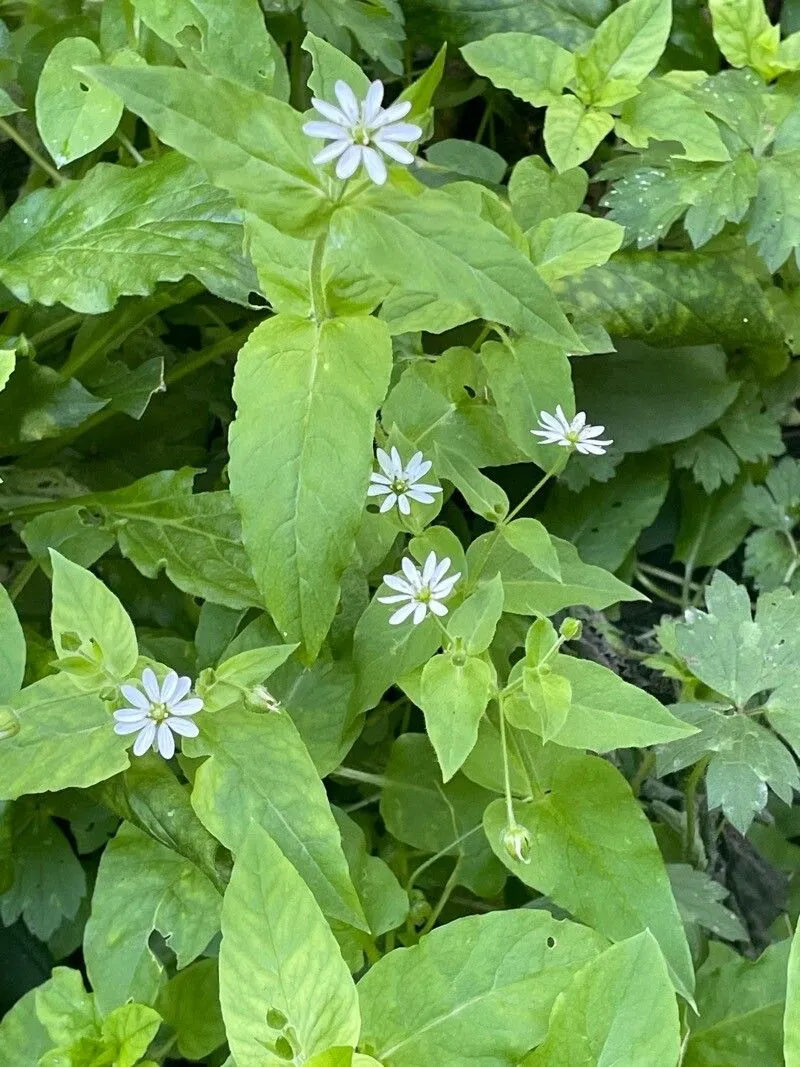
Author: (L.) Scop.
Bibliography: Fl. Carniol., ed. 2, 1: 319 (1771)
Year: 1771
Status: accepted
Rank: species
Genus: Stellaria
Vegetable: Unknown
Observations: Temp. Eurasia
Giant chickweed, scientifically known as Stellaria aquatica, is a fascinating plant species belonging to the Caryophyllaceae family. This species was first documented in the second edition of “Flora Carniolica” in 1771 by the renowned botanist Giovanni Antonio Scopoli, who provided a comprehensive description of its characteristics and habitat.
Native to temperate regions across Eurasia, Stellaria aquatica thrives in a variety of environmental conditions. It is typically found in moist, nutrient-rich soils, often along the banks of rivers, streams, and in wet meadows. The plant’s preference for such habitats is likely due to its high water content and structural adaptability, allowing it to flourish in these conditions.
Giant chickweed is easily identifiable by its delicate, star-shaped flowers, which usually bloom in the spring and summer. These small, white flowers are borne on slender stalks and feature five deeply bifurcated petals, giving them a distinct appearance that resembles a star – hence the genus name Stellaria, derived from the Latin word ‘stella’ meaning ‘star.’
The plant’s foliage is also quite characteristic, with opposite leaves that vary from lanceolate to ovate in shape. The leaves are typically smooth and bright green, contributing to the plant’s lush, verdant appearance. Giant chickweed can grow to be quite tall, living up to its common name, and can reach heights of up to one meter under optimal conditions.
In its natural habitat, Stellaria aquatica plays a crucial role in the ecosystem. It serves as a source of food for various insect species, which in turn pollinate the flowers, helping in the plant’s reproduction. Additionally, it provides habitat and cover for small wildlife.
Giant chickweed has also drawn interest for its potential medicinal properties, a trait shared by many members of the Caryophyllaceae family. Although not as commonly utilized as some of its relatives, there are traditional uses of this plant in some cultures, primarily for its soothing properties and as a treatment for minor ailments.
Overall, Stellaria aquatica is a plant of significant ecological and botanical interest. Its presence across Eurasia’s temperate regions and its distinctive morphological features make it a noteworthy species within the Caryophyllaceae family. Whether for scientific observation, ecological study, or simple appreciation of its beauty, Giant chickweed remains a valuable component of the natural world.
En: Giant Chickweed
Nl: Watermuur
Fi: Vata
De: Wassermiere, Wasser-Miere, Wasserdarm, Wasser-Sternmiere, Wasserdarm
It: Centocchio acquatico
© copyright of the Board of Trustees of the Royal Botanic Gardens, Kew.
© copyright of the Board of Trustees of the Royal Botanic Gardens, Kew.
© copyright of the Board of Trustees of the Royal Botanic Gardens, Kew.
Taken Oct 26, 2022 by Luit Van Hunenstijn (cc-by-sa)
Taken Aug 11, 2020 by Jaak Pärtel (cc-by-sa)
Taken Sep 25, 2022 by 省三 小谷 (cc-by-sa)
Taken Aug 11, 2020 by Jaak Pärtel (cc-by-sa)
Taken Sep 24, 2022 by David Hocken (cc-by-sa)
Taken Aug 11, 2020 by Jaak Pärtel (cc-by-sa)
Taken Aug 11, 2020 by Jaak Pärtel (cc-by-sa)
Taken Sep 24, 2022 by David Hocken (cc-by-sa)
Taken Sep 24, 2022 by David Hocken (cc-by-sa)
Family: Myrtaceae Author: (F.Muell.) K.D.Hill & L.A.S.Johnson Bibliography: Telopea 6: 402 (1995) Year: 1995 Status:…
Family: Rubiaceae Author: Pierre ex A.Froehner Bibliography: Notizbl. Bot. Gart. Berlin-Dahlem 1: 237 (1897) Year:…
Family: Sapindaceae Author: Koidz. Bibliography: J. Coll. Sci. Imp. Univ. Tokyo 32(1): 38 (1911) Year:…
Family: Asteraceae Author: A.Gray Bibliography: Pacif. Railr. Rep.: 107 (1857) Year: 1857 Status: accepted Rank:…
Family: Fabaceae Author: Medik. Bibliography: Vorles. Churpfälz. Phys.-Ökon. Ges. 2: 398 (1787) Year: 1787 Status:…
Family: Aspleniaceae Author: (Cav.) Alston Bibliography: Bull. Misc. Inform. Kew 1932: 309 (1932) Year: 1932…